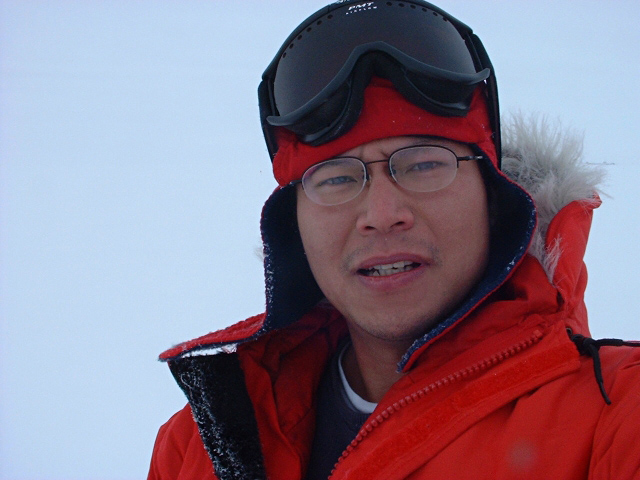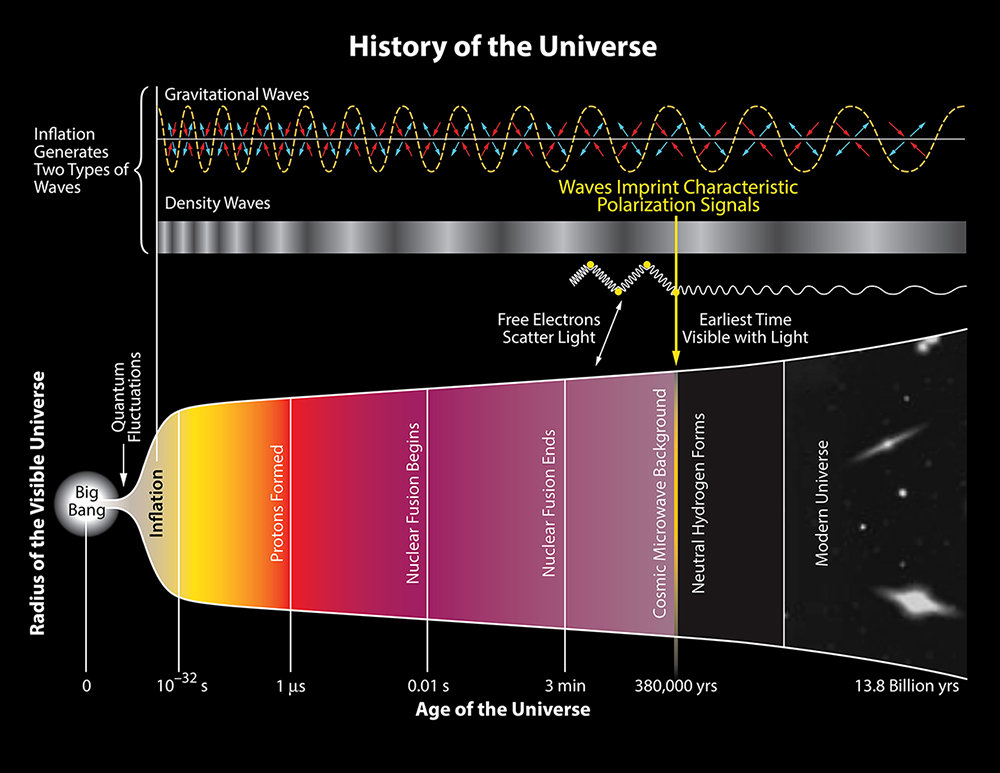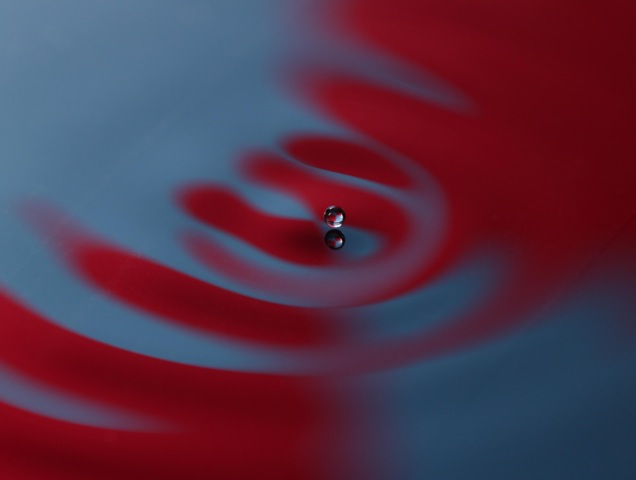Early-Universe Explorer Looks for Answers

On March 17, a panel of four astrophysicists held a press conference at the Harvard-Smithsonian Center for Astrophysics in Cambridge, Mass., to announce that they had discovered features in the cosmic microwave background (CMB) that are consistent with gravitational waves from the universe’s first moments. The results agreed with predictions from the decades-old theory of inflation, said panelist Chao-Lin Kuo of Stanford University, providing the first direct evidence that for an infinitesimal instant after the Big Bang, our universe expanded faster than the speed of light.
Kuo had designed the sensitive photon detectors in the telescope responsible for the breakthrough. For three years in the cold, dry atmosphere of the South Pole, the Background Imaging of Cosmic Extragalactic Polarization (BICEP2) telescope collected photons from the CMB, the 13.8-billion-year-old residue of the Big Bang. Information describing the intensity and polarization of the captured photons was transmitted by satellite to an international collaboration of 47 researchers working at various institutes. Gradually, a pattern of polarized light emerged. The researchers were initially reluctant to interpret the data as evidence for primordial gravitational waves. They labored to rule out alternative explanations for the signal, including the possibility that the pattern had been generated not by gravitational waves but by dust in the Milky Way.
Over time, however, the BICEP2 team became convinced that the curly “B-mode” polarization pattern had been created by waves of gravity during inflation. Concurrently with the press conference, the BICEP2 team released a non-peer-reviewed preprint paper detailing the methods and results of their experiment, writing that “a new era of B-mode cosmology has begun.” The Stanford University office of public affairs produced a video clip of Kuo delivering the news about the discovery to one of the originators of the theory of inflation, Andrei Linde, a physicist at Stanford. The emotionally compelling video went viral, garnering 2.8 million views on YouTube as of this writing.
Yet the euphoria of discovery was not to last: In May, the European Space Agency’s Planck space observatory published CMB dust polarization maps that undermined BICEP2’s claim to have found gravitational waves. Cosmologists published papers critiquing the BICEP2 claim on the basis that the B-mode signals could have been generated by silicon dust floating in the telescope’s observational foreground.
In mid-June, Physical Review Letters published BICEP2’s revised paper. The researchers stood by the accuracy of the measurement itself, but noted that it is possible that galactic dust could be responsible for what they had previously thought to be gravitational waves.
Quanta Magazine caught up with Kuo at a cosmology conference at the University of Chicago a few days before the publication of the revised paper. This is a condensed and edited version of that conversation and a follow-up by email.
QUANTA MAGAZINE: What is your role with BICEP2?
CHAO-LIN KUO: I designed the superconducting antenna technology and supervised the construction of the telescope at the Jet Propulsion Laboratory. Using this technology, we created an instrument capable of detecting the existence of primordial gravitational waves. And now we have greatly improved upon BICEP2’s sensitivity by building the Keck Array, an additional telescope, which is deployed next door to BICEP2. We are also working on a next-generation telescope called BICEP3. The Keck Array and BICEP3 will pick up the search for gravitational waves where BICEP2 left off.
I am an experimentalist whose job is to make measurements and let the theoretical chips fall where they may.
In the YouTube video that went viral, you speak the phrase “r = 0.2” to Andrei Linde, and he is overjoyed. What is the meaning of that equation?
In the mid-1990s, theorists realized that we can search for gravitational waves directly by looking at the polarization state of the cosmic microwave background. Using the BICEP2 telescope, it took us three years to map out the polarization in a small region of the sky at the South Pole. Not to get too technical, but polarization of the CMB boils down to finding two different types of patterns called E-modes and B-modes.
We found that 20 percent of the polarization of the microwave background that we observed is B-mode, which can be caused by gravitational waves or by galactic dust and other sources. Using available dust maps from other CMB experiments, we discounted the possibility that galactic dust or other sources caused the bulk of the B-mode signals that we observed, leaving gravitational waves as the simplest explanation.
The equation “r = 0.2” means that 20 percent of the total polarization is caused by gravitational waves. Importantly, it means that we can assess the energy scale of inflation. If r = 0.2, the energy scale was high enough that the force of gravity and quantum mechanics must have been combined as the universe was born. This validates large-field inflation models as proposed by Linde and other cosmologists, such as Alan Guth.
When you started out, did you expect to verify the theory of inflation?
As an experimentalist, I look for testable ideas, and inflation made testable predictions. I personally like the explanatory power of the theory of inflation. But I am an experimentalist whose job is to make measurements and let the theoretical chips fall where they may.

After BICEP2 announced the discovery of gravitational waves, a number of cosmologists, including Raphael Flauger, David Spergel, Michael J. Mortonson and Uroš Seljak, wrote papers saying that the B-modes that you and your colleagues have interpreted as evidence for gravitational waves could equally well be caused by clouds of galactic dust. Are they correct?
It is a very normal process in science to propose alternative explanations. BICEP2 saw a very significant level of B-mode polarization at a frequency of 150 GHz. We tried for a year to make the signal go away, and we failed — it is still there. We are now certain that it is from the sky and not from instrumental artifacts. For more than a decade, astronomers have modeled polarized dust in the foreground of our galaxy, the Milky Way, at a low or modest polarization of about 5 percent, not enough to explain our signal. And there is some supporting evidence for the B-mode signal being gravitational waves from data collected earlier in the decade by the BICEP1 telescope at a frequency of 100 GHz. Gravitational waves remained a very likely explanation, and the most economical one.
But in early May, after we had released our preprint, the Planck collaborative published dust polarization data from its 350 GHz polarization measurements. That data shows that dust polarization across the whole sky is more significant than we had anticipated.
What did the release of the new Planck data mean for the discovery of gravitational waves you announced in March?
The Planck map did not cover the region over the South Pole where our telescope observes. Planck will be releasing more data soon. If we get “unlucky,” the polarized dust that Planck observed could explain all of our B-mode signal. So we wait.
In the revised BICEP2 paper published in Physical Review Letters, your team expresses less certainty about its original findings. Why?
All we had on hand from Planck before we released our preprint was a map from a slide in a presentation made over a year ago. When we looked at the slide, we made assumptions about what the image meant, and then we made our best estimate of dust polarization based on that assumption. Our assumption basically agreed with prior models of galactic dust polarization. We could not completely check out our assumptions, because the slide was the only Planck dust map to which we had access. In the revised paper, we removed the dust model based on the Planck image, due to uncertainties.
You did not have access to Planck’s raw data?
We did not have Planck’s raw data when we made our assumptions about dust polarization coverage. And when Planck published the data, it excluded our observational region at the South Pole from the map. When Planck releases more dust polarization data for our sector of the sky, we will have a better idea about whether the B-modes are gravitational waves or dust.
How do you feel about having announced the discovery of gravitational waves in light of the new Planck data and the subsequent critiques?
We have always acknowledged that there is uncertainty about dust. And now, the uncertainty seems to be bigger.
You must have an emotional investment in the outcome.
Personally, I only care about the truth. I am not worried about looking good all the time. I only care about how much of the polarization signal we see in the data is caused by dust, and how much is caused by primordial gravitational waves. As experimentalists, we want to make the best measurement possible. When reporters say, “Oh, you have done something wrong!” that is hurtful to me. The fact is that we have now adjusted our interpretation based on the new information. Importantly, the data points have not moved one bit. It is only the interpretation that has evolved.
Was everybody on the BICEP2 team in agreement with the original interpretation that the excess B-mode signal was caused by gravitational waves?
With the information we had on hand at the time we released the preprint, there was really nothing to disagree about concerning the data. We will have more data soon, from Planck, the Keck Array and BICEP3. Regardless of whether the BICEP2 signal turns out to be foreground dust or primordial gravitational waves, we will be moving forward with our research.
Should research groups that are competing to find gravitational waves share raw data before announcing discoveries?
We do plan to work with other groups to jointly analyze our data. A data release is not a trivial thing. The various groups process CMB data differently, and instrument properties differ and must be understood. A collaboration is in the works for 2020 called CMB-S4 that calls for more data sharing among the different research groups.
Is there a lesson to be learned in all of this?
The process of interpretation may appear a bit messy to outsiders, but we are making rapid progress in science. Again, I only care about finding the answer.
This article was reprinted on ScientificAmerican.com.



